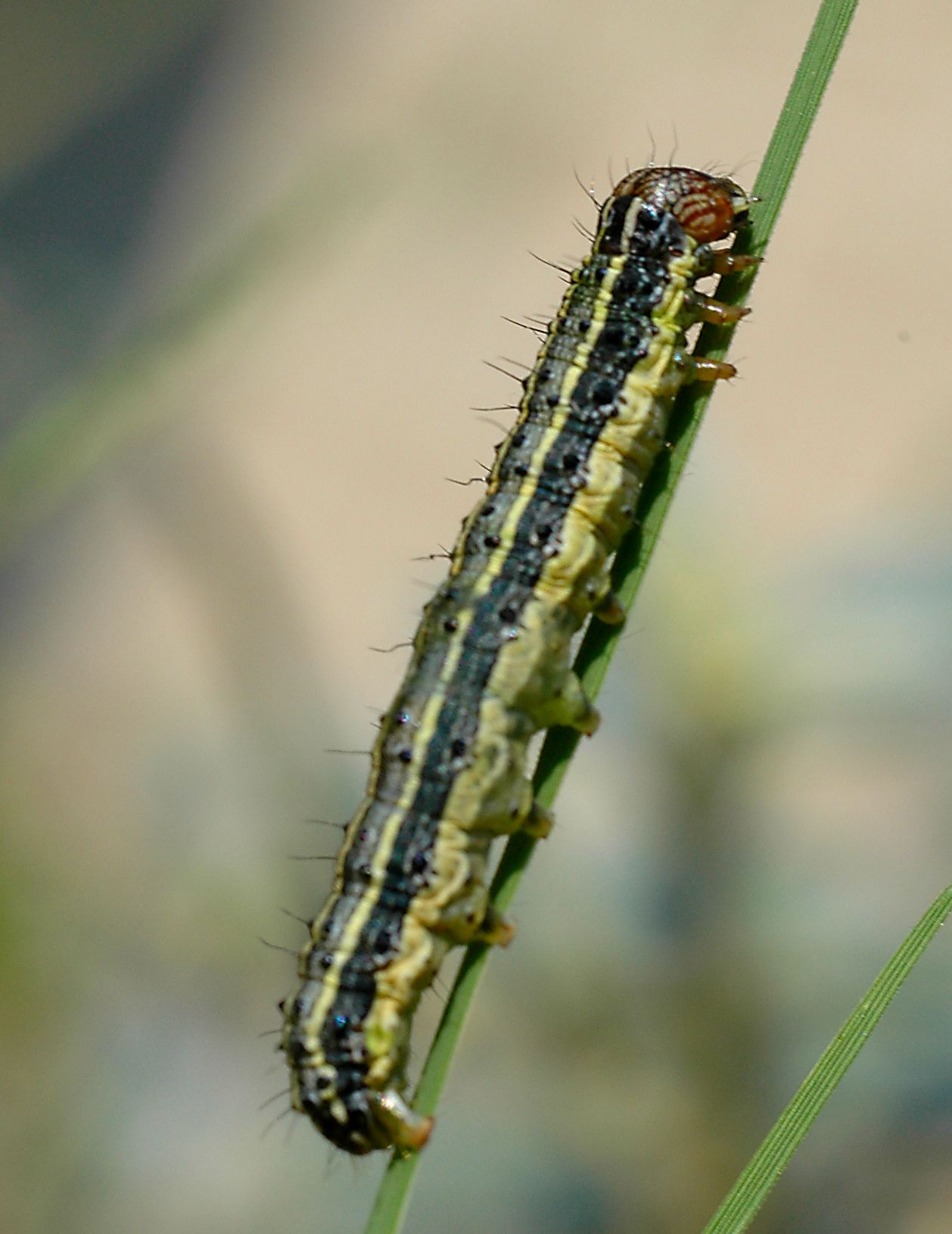|
Many insect pests have survival strategies for cold weather
Overton, Texas, USA
January 21, 2014
Will the extremely cold weather Texas experienced recently have any effect on insect populations this spring?

Armyworms, which are actually the larval form of a moth, deal with cold weather by not being around when it happens, according to a Texas A&M AgriLife Extension Service entomologist. Armyworm moths overwinter in South Texas and migrate in the millions northward in the spring and summer to lay their eggs. (Texas A&M AgriLife Extension Service photo by Robert Burns)
Probably not, said Erfan Vafaie, Texas A&M AgriLife Extension Service integrated pest management specialist at Overton.
“It depends upon the insect,” said Vafaie.
Red imported fire ants, for example, burrow down so deeply in the soil that they’re unlikely to be affected by cold weather, Vafaie said.
“They tend to be quite ‘insulated’, if you will, from the extreme temperature changes — unless there’s a very long sustained cold, which may slowly make its way down into the depths,” he said.
It’s been suggested by other entomologists, Vafaie said, that a colder winter may reduce the populations of mosquito species that carry West Nile virus during the following summer.
“However, we don’t know for a certainty, and since this winter has been quite a unique one in Texas, we’ll have to wait and see how insect populations have been affected.”
What is known is that insects generally have several biological mechanisms for dealing with cold weather, even extremely frigid weather like large parts of Texas had in late December.
Vafaie’s previous work under the supervision of Dr. Brent Sinclair, a prominent insect low-temperature biologist in Ontario, Canada, gave him a strong foundation and knowledge on insect cold tolerance, he said.
“There are many places that often experience much cooler climates than Texas, such as Toronto, that had below minus 20 this December,” Vafaie said. “Although it may seem as though our little insect friends would not be able to live at such low temperatures, many have adapted the ability to survive in such environments.”
Generally speaking, insects have three main strategies for dealing with the cold: freeze tolerance, freeze avoidance and migration, he said.
“Internal ice formation would kill most organisms, but some insects have specialized mechanisms to deal with ice,” Vafaie said. “Some insects, such as the woolly bear, a moth larva, and goldenrod gall fly larvae, can tolerate freezing by the use of specialized proteins.”
He noted that though such insects are termed “freeze tolerant,” if they are taken from the field during the summer and placed in a freezer, they aren’t likely to survive.
“Typically, certain environmental cues are involved. For example, shorter days and cooling temperatures may induce mechanisms that help the insect tolerate freezing,” Vafaie said. “When the weather warms back up, they thaw and become active again.”
Other insects cannot tolerate freezing, but have other mechanisms to prevent ice formation in their cells, he said.
“We call 32 Fahrenheit the freezing point of water, but the temperature at which ice forms depends on the content of the solution,” Vafaie said. “For example, saltwater at a concentration of 23.3 percent may not freeze until the temperature is minus 6 degrees Fahrenheit. In the same way, some insects use certain compounds called ‘cryoprotectants,’ similar to the ethylene glycol found in your car’s antifreeze, that lower the temperature at which freezing occurs. This helps them survive at subfreezing temperatures.”
The third strategy, migration, is also commonly used by some species of insects. In East Texas, one of the most common examples of this strategy is the fall armyworm, he said.
The fall armyworm is actually the larval form of a migrating moth, he said.
Fall armyworm moths migrate in the millions northward from South Texas in the spring and summer. Upon arrival, each moth will deposit a clump of 50 or more eggs on individual blades of grass. When the eggs hatch, the larva quickly go on maneuvers en masse for food. They will move across pastures, devouring wide swathes of grass in their wake, like an advancing army, hence their name.
Another migratory example is the monarch butterfly, Vafaie said.
“Monarchs migrate to Mexico and Southern California every winter,” he said.
One thing that may defeat many of these survival strategies, however, is when there are multiple incidences of very cold weather with warm temperatures in between. Such rollercoaster weather can decrease insect survival or reproductive potential, according to Vafaie.
“It’s not that they don’t have strategies adapted to deal with frequent temperature variations; it just comes at a cost, for example survival or reproduction,” he said.
But even when winter knocks back survival numbers, nature has a way of adjusting, Vafaie said.
“Due to the relatively short generation time of some of our biggest pests, like aphids, whiteflies and mites, their populations can grow exponentially even if winter survival is low.”
More news from: Texas A&M AgriLife
Website: http://agrilife.org/ Published: January 21, 2014 |